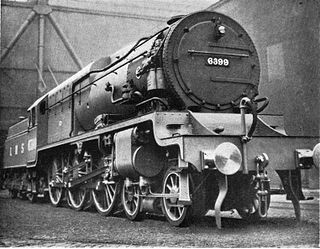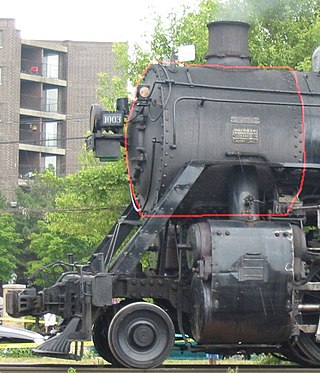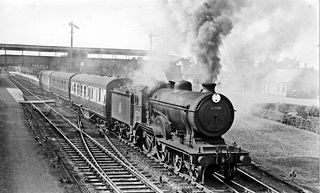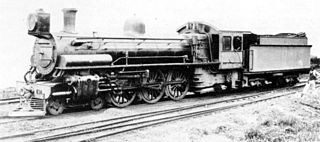Related Research Articles

The London, Midland and Scottish Railway (LMS) Princess Royal Class is a class of express passenger 4-6-2 steam locomotive designed by William Stanier. Twelve examples were built at Crewe Works, between 1933 and 1935, for use on the West Coast Main Line. Two are preserved.

The London, Midland and Scottish Railway (LMS) Jubilee Class is a class of steam locomotive designed for main line passenger work. 191 locomotives were built between 1934 and 1936. They were built concurrently with the similar looking LMS Stanier Class 5 4-6-0. They were nicknamed Red Staniers and Jubs.

The Great Western Railway 3252 or Duke Class were 4-4-0 steam locomotives with outside frames and parallel domed boilers. They were built in five batches between 1895 and 1899 for express passenger train work in Devon and Cornwall. William Dean was their designer, possibly with the collaboration of his assistant, George Jackson Churchward. Four prototype 4-4-0s, of the Armstrong Class, had already been built in 1894.

The London, Midland and Scottish Railway (LMS) Stanier Class 5 4-6-0, commonly known as the Black Five, is a class of 4-6-0 steam locomotives. It was introduced by William Stanier and built between 1934 and 1951, of which 842 were built and were numbered 4658-5499. Several members of the class survived to the last day of steam on British Railways in 1968, and eighteen are preserved.

The London, Midland and Scottish Railway (LMS) Royal Scot Class is a class of 4-6-0 express passenger locomotive introduced in 1927. Originally having parallel boilers, all members were later rebuilt with tapered type 2A boilers, and were in effect two classes.

The London, Midland and Scottish Railway (LMS) No. 6399 Fury was an unsuccessful British experimental express passenger locomotive. The intention was to save fuel by using high-pressure steam, which is thermodynamically more efficient than low-pressure steam.

A smokebox is one of the major basic parts of a steam locomotive exhaust system. Smoke and hot gases pass from the firebox through tubes where they pass heat to the surrounding water in the boiler. The smoke then enters the smokebox, and is exhausted to the atmosphere through the chimney. Early locomotives had no smokebox and relied on a long chimney to provide natural draught for the fire but smokeboxes were soon included in the design for two specific reasons. Firstly and most importantly, the blast of exhaust steam from the cylinders, when directed upwards through an airtight smokebox with an appropriate design of exhaust nozzle, effectively draws hot gases through the boiler tubes and flues and, consequently, fresh combustion air into the firebox. Secondly, the smokebox provides a convenient collection point for ash and cinders ("char") drawn through the boiler tubes, which can be easily cleaned out at the end of a working day. Without a smokebox, all char must pass up the chimney or it will collect in the tubes and flues themselves, gradually blocking them.

The London, Midland and Scottish Railway (LMS) 6170British Legion was a British steam locomotive. It was the prototype for, and is sometimes considered a member of, the Rebuilt Royal Scot Class but differed from those later rebuilds principally in having a unique type 2 boiler, rather than a type 2A boiler, the two not being interchangeable.

The Northern Counties Committee (NCC) Class U2 4-4-0 passenger steam locomotives consisted of 18 locomotives built for service in north-east Ireland. Ten of the engines were new builds supplied by the North British Locomotive Company (NBL) or constructed at the NCC's York Road works. The remainder were rebuilds of existing locomotives.

The LNER W1 No. 10000 was an experimental steam locomotive fitted with a high pressure water-tube boiler. Nigel Gresley was impressed by the results of using high-pressure steam in marine applications and so in 1924 he approached Harold Yarrow of shipyard and boilermakers Yarrow & Company of Glasgow to design a suitable boiler for a railway locomotive, based on Yarrow's design.

The GER Classes S46, D56 and H88 were three classes of similar 4-4-0 steam locomotive designed by James Holden and A. J. Hill (H88) for the Great Eastern Railway.
The LMS (Northern Counties Committee)Class A1 4-4-0 passenger steam locomotives were rebuilds of Belfast and Northern Counties Railway Class A two-cylinder compound locomotives. They operated services throughout the NCC’s 5 ft 3 in (1,600 mm) broad gauge system in the north-east of Ireland.
The Midland Railway Johnson 0-6-0 were a class of locomotives serving Britain's Midland Railway system in the late 19th and early 20th centuries. Between 1875 and 1908 the Midland Railway, under the control of locomotive superintendents Samuel Waite Johnson and Richard Deeley, ordered 935 goods tender engines of 0-6-0 type, both from the railway's own shops at Derby and various external suppliers. Although there were many variations between different batches both as delivered and as successively rebuilt, all 935 can be regarded as a single series, one of the largest classes of engine on Britain's railways. The locomotives served as late as 1964, but none of them now survive.
Boilers for generating steam or hot water have been designed in countless shapes, sizes and configurations. An extensive terminology has evolved to describe their common features. This glossary provides definitions for these terms.

The chimney is the part of a steam locomotive through which smoke leaves the boiler. As well, steam locomotive exhaust systems typically vent cylinder steam exhaust through the chimney, to enhance the draught through the boiler. Chimneys are designed to carry the exhaust steam and smoke clear of the driver's line of sight while remaining short enough to clear overhead structures. Some chimneys included apparatus to suppress the dispersal of sparks.

The South African Railways Class 10B 4-6-2 of 1910 was a steam locomotive from the pre-Union era in Transvaal.

The South African Railways Class 10A 4-6-2 of 1910 was a steam locomotive from the pre-Union era in Transvaal.

The South African Railways Class 6L 4-6-0 of 1904 was a steam locomotive from the pre-Union era in the Cape of Good Hope.
The Great Southern and Western Railway (GS&WR) Class 351 initially consisted of four 0-6-0 tender locomotives designed by Robert Coey for use on heavy freight trains on the main line. They were joined by four similar locomotives built in 1912 introduced by Richard Maunsell, these had detail differences such as larger cabs and higher running plates. They included an extended smokebox to which a Phoenix superheater was briefly trialed but abandoned. They were initially designated GS&WR Class 249 but were subsequently grouped into class 351.

A double chimney is a form of chimney for a steam locomotive, where the conventional single opening is duplicated, together with the blastpipe beneath it. Although the internal openings form two circles, the outside appearance usually forms a single elongated oval.